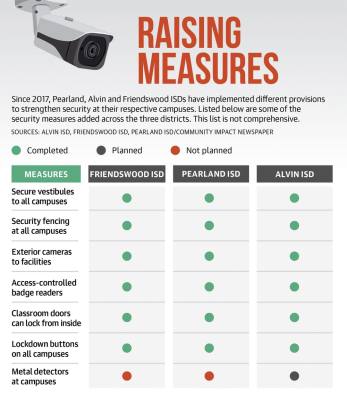Pearland, Alvin and Friendswood ISDs are reassessing security protocols at their campuses in response to the May shooting at Robb Elementary School in Uvalde, Texas, that left 19 students and two teachers dead.
The three school districts, along with those across the state, are undergoing several measures, including safety audits, updating lockdown protocols and upgrading security equipment in an effort to make their campuses safer in advance of the 2022-23 school year.
“Once these [tragedies] happen, it always makes us step back and re-evaluate and say, ‘Are we absolutely doing everything that we can to ensure that our schools are safe?’” said Brad Hayes, PISD director of safe and secure schools, during the district’s June 14 board meeting.
State lawmakers are also assessing the best route to effectively protect students. The Robb Elementary School shooting marked the third-deadliest school shooting in the U.S. and the deadliest in Texas over the last five years, according to Gun Violence Archive, a nonprofit group that hosts a platform focusing on gun violence statistics across the country.
In response to the tragedy, Gov. Greg Abbott on June 1 sent a letter to the Texas Education Agency and Texas School Safety Center, a university-level research center at Texas State University that is tasked with spreading information on safety initiatives and state mandates, according to the Texas Education Code and Abbott’s Homeland Security Strategic Plan.
The governor’s letter set expectations following the shooting at Robb Elementary, PISD Superintendent Larry Berger said. In late June, the state approved an additional $105.5 million for school safety and mental health initiatives, according to information provided by the TEA in an email.
The funds will be transferred to individual state agencies, which will then be tasked with funneling it to districts as needed. The TEA is in the process of setting up a grant program for districts to acquire their share of $17.1 million designated for the purchase of silent panic alert technology, the TEA said.
“With the new school year starting in a few short months, it is of paramount importance that we provide this funding to improve school safety and mental health services,” Lt. Gov. Dan Patrick said in a June 28 state news release announcing the funding.
Districts’ response
In the wake of the shooting, the TEA established a list of requirements each district needs to complete with the goal of improving the safety and security of school facilities for staff, students and visitors before students return for the 2022-23 school year, according to the TEA.
Among the new regulations, the TEA is requiring each district to conduct safety audits; inspect all exterior doors on district facilities, which played a key factor in the Robb Elementary shooting; and train district threat assessment teams.
“All Texas school systems must [complete these] prior to the start of the new school year,” TEA officials said in the statement.
PISD is auditing each of its campuses throughout the summer, focusing on the doors at each facility, Hayes said. Additionally, PISD is adding measures to monitor doors more frequently and focusing on fixing any doors that may be faulty, he said. All classroom doors at PISD will be locked throughout the school day.
“After 20 years in education, Pearland ISD schools are some of the most secure that I have ever seen in my entire life,” Hayes said.
AISD’s security measures in place exceeded the state’s requirements ahead of the 2022-23 school year, AISD Director of Communications Renae Rives said.
While no new specific safety measures have been announced by the district, Rives said leadership is constantly reviewing safety measures and updating them as needed. AISD’s proposed fiscal year 2022-23 police budget includes a $556,000—or 12.1%—increase compared to FY 2021-22’s budget, which will fund added personnel and equipment.
At FISD, inspections of every exterior door at instructional facilities are underway per TEA requirements, said J.T. Patton, FISD’s executive director of safety and operations. The district has identified and addressed issues with a few gates and exterior doors, he said.
When the school year begins, the TEA will require districts to conduct exterior door sweeps at every instructional facility at least once per week while classes are ongoing; however, FISD plans to have its security monitors conduct the sweeps once per hour. Any issues found will be reported to campus administration immediately, Patton said.
Santa Fe aftermath
School district officials in the Pearland and Friendswood area have had to react to school shootings in the past. The three districts made changes to their procedures following the May 2018 shooting at Santa Fe High School, located a 30-minute drive south of Pearland and 10 minutes east of Alvin.
PISD spent $771,195 in 2018 to add 11 positions, including six counselors and special education personnel aimed at the mental health needs of students, Hayes said.
“We cannot overlook the need to have mental health support in place for our students, and thus, after Santa Fe, our district committed to adding student support counselors,” Hayes said.
Additionally, PISD added interior locks to all classroom doors in 2019, which allows students and teachers inside the classrooms to lock the door without using a key and having to enter the hallway, Hayes said.
AISD spent money from a $480.5 million bond approved by voters in November 2018 to upgrade school security, including fencing around all AISD schools and retrofitting some schools with security vestibules, AISD Superintendent Carol Nelson said.
Nelson said AISD has three officers on each high school campus, and all AISD junior high schools have a full-time officer.
“We have a force of about 40 officers,” Nelson said. “The average experience level is 17 years. We don’t hire brand-new officers; we hire officers who have worked out in other agencies.”
Following the Santa Fe High School shooting, FISD overhauled its Safety Action Plan and began efforts in summer 2018 to reshape school safety by forming the FISD Safety Action Committee, which is responsible for advising the board of trustees on its emergency operation plans, according to the district’s website.
“Being neighbors to Santa Fe and walking through that pain together that year, we’ve gone through a lot of that,” Patton said.
Additionally, construction began in fall 2018 on safety vestibules at all FISD buildings, which include 911 emergency call buttons and safety film to reinforce windows. Construction on the final vestibule at Friendswood Junior High School, which cost $120,000, will be finished this summer.
The district upgraded doors and reinforced walls at Westwood Elementary and Friendswood High schools, and Cline Elementary and Windsong Intermediate schools received safety fencing around the perimeter of each campus, according to FISD Public Information Officer Dayna Owen.
All campuses also received safety monitors who monitor entry points and parking areas to maintain buildings’ physical security, a core part of FISD’s first layer of safety.
Future goals
One of the procedures AISD has in place for the upcoming school year includes conducting daily audits of campuses, including a system of checking for open doors and documenting when doors are left open, Nelson said.
“There’s a lot of things that go on behind the scenes,” she said.
For the upcoming school year, FISD encourages a change in mindset amongst district staff regarding safety. Rather than assuming someone else will handle a safety concern, Patton said the district will focus on everyone taking more responsibility.
“Safety can’t just go to one person. We’re going to talk a lot about that this year and bang on that drum about the importance of [safety] being collective,” Patton said.
Additional safety measures to come in FISD include improved cell phone coverage throughout campuses, more card readers and security camera upgrades, all to be installed this summer and funded by the 2020 bond.
Meanwhile, PISD will review its protocols during the summer, which include training on door policies for teachers and staff, updating watchdog and hallway hero programs, and training the district’s school resource officers, Hayes said. PISD will also increase the number of campus audits throughout the school year from three to six.
Additionally, PISD is looking at different ways to improve security and is working with its safety committee—which includes Berger, board President Sean Murphy, a Pearland Police Department representative and other members—on new ideas that may include adding secondary entrance security and metal detectors, Hayes said.
“Everything that we do buys time,” Hayes said. “Time buys options.”
Hunter Marrow contributed to this story.









